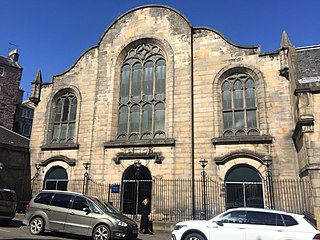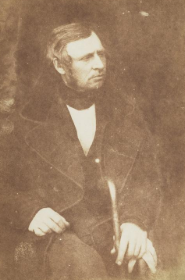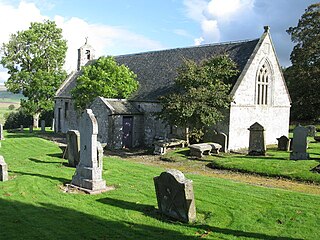
East Linton is a village and former police burgh in East Lothian, Scotland, situated on the River Tyne and A199 road five miles east of Haddington, with an estimated population of 1,790 in 2022. During the 19th century the population increased from 715 inhabitants in 1831 to 1,042 by 1881. The 1961 census showed the village had a population of 1,579. The number dropped significantly at the end of the 20th century, but has subsequently risen again.

The Royal Burgh of Haddington is a town in East Lothian, Scotland. It is the main administrative, cultural and geographical centre for East Lothian. It lies about 17 miles east of Edinburgh. The name Haddington is Anglo-Saxon, dating from the sixth or seventh century AD when the area was incorporated into the kingdom of Bernicia. The town, like the rest of the Lothian region, was ceded by King Edgar of England and became part of Scotland in the tenth century. Haddington received Burgh status, one of the earliest to do so, during the reign of David I (1124–1153), giving it trading rights which encouraged its growth into a market town.
William Colvill, sometimes spelt William Colville (c.1612–1675) was a 17th-century Scottish minister of the Church of Scotland and scholar and was the Principal of the University of Edinburgh from 1662 to 1675.
Gilbert Rule was a nonconformist Church of Scotland minister and the Principal of the University of Edinburgh from 1690 to 1701.
John Ballantyne CairnsKCVO KStJ is a retired minister of the Church of Scotland.
James Livingston was a 15th-century cleric from East Lothian in south-eastern Scotland. Born at an unknown date in the 15th century, he was a son of the Laird of Saltcoats. He chose a career in the church, and became rector of the churches of Forteviot and Weme, and vicar of Innerleithen. By 1474, if not earlier, he had become dean for the whole diocese of Dunkeld. After the death of Thomas Lauder, Livingston was chosen as his successor as Bishop of Dunkeld. Although Livingston's appointment was contested at Rome by Thomas Spens, Bishop of Aberdeen, who wanted to be translated to Dunkeld, Livingston was consecrated on 30 June 1476. Livingston's episcopate is relatively obscure; he spent a good deal of time in Edinburgh, where he is witness to several charters. He died at Edinburgh, on 28 August 1483. He was buried in Inchcolm.

Hew Scott (1791–1872) was a minister of the Church of Scotland parish of Anstruther Wester. He is largely remembered as a religious researcher and author. His "magnum opus" is the comprehensive, multi-volume work, Fasti Ecclesiae Scoticanae: The succession of ministers in the parish churches of Scotland, from the reformation, A.D. 1560, to the present time. This is a detailed, biographical record of each of the ministers of each of the parishes of the Church of Scotland from 1560 to 1870.. It was first published between 1866 and 1871 but it is regularly updated by the Church of Scotland.
Fasti Ecclesiae Scoticanae, The Succession of Ministers in the Church of Scotland from the Reformation is a title given to books containing lists of ministers from the Church of Scotland. The original volumes covered all ministers of the Established Church of Scotland. Volumes I-VII were published on a regional basis, later volumes cover the whole of the Church of Scotland:

Robert Wallace was a British writer who had a varied career as a classics teacher, minister, university professor, newspaper editor, barrister, and finally a Member of Parliament for Edinburgh East.

Lady Yester's Kirk was a parish church of the Church of Scotland and one of the burgh churches of Edinburgh. Founded in 1647, it served the south-eastern part of Edinburgh's Old Town until its union with Greyfriars Kirk in 1938.
Andrew Honeyman or Honyman (1619–1676) was a Scottish priest: he was Bishop of Orkney from 1664 until 1676.

Angus Makellar (1780–1859) was a Scottish minister of the Church of Scotland who served as Moderator of the General Assembly of the Church of Scotland in 1840. Leaving in the Disruption of 1843 he also served as Moderator of the General Assembly of the Free Church of Scotland in 1852.

John Cook (1807–1874) was a Scottish minister who served as Moderator of the General Assembly of the Church of Scotland for the year 1866/67. In common with other members of the ecclesiastical family of Cook, he was a strong supporter of the moderate party in the Scottish church.

Patrick Anderson of Walston was a 17th-century minister and Covenanter.

Rev Thomas Hog of Kiltearn (1628–1692) was a controversial 17th century Scottish minister.

John Greig was a Presbyterian minister from Scotland.

John Law (1632–1712) was a 17th-century Presbyterian minister from Scotland. He became Moderator of the General Assembly in 1694 and later was a prisoner on the Bass Rock.
George Hamilton (1757–1832) was a Church of Scotland minister who served as Moderator of the General Assembly in 1805.
John Currie (c.1670–1720) was a Church of Scotland minister who served as Moderator of the General Assembly in 1709.
Robert Patoun AM (1690–1768) was an 18th-century Church of Scotland minister who served as Moderator of the General Assembly in 1750.











